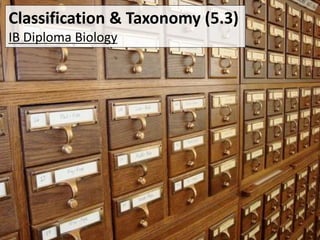
IB Biology 5.3 Slides: Classification & Taxonomy
- 1. Classification & Taxonomy (5.3) IB Diploma Biology
- 7. 5.3.1 The binomial system of names for species is universal among biologists and has been agreed and developed at a series of congresses.
- 8. 5.3.2 When species are discovered they are given scientific names using the binomial system.
- 10. 5.3.4 All organisms are classified into three domains.
- 11. • Prokaryotic cells • Cell walls (No Peptidoglycan) • Ether lipids in membranes • Histone-like proteins bind DNA • Live in extreme environments (aka “Extremophiles”) such as boiling hot springs and arctic ice • Methanogens • Unicellular Archaea
- 12. Bacteria • Prokaryotic cells • Cell walls (Peptidoglycan) • Ester lipids in membranes • ‘Naked’ DNA • Unicellular
- 13. Eukarya • Eukaryotic cells • Sometimes cell walls present (Cellulose or Chitin) • Ester lipids in membranes • Histone proteins bind DNA • Mostly multicellular
- 14. 5.3.3 Taxonomists classify species using a hierarchy of taxa / 5.3.5 The principal taxa for classifying eukaryotes are kingdom, phylum, class, order, family, genus, and species.
- 17. 5.3.9 Classification of one plant and one animal species from domain to species level. Taxon Grey Wolf Date palm Kingdom Animalia Plantae Phylum Chordata Angiospermophyta Class Mammalia Monocotyledoneae Order Carnivora Palmales Family Canidae Arecaceae Genus Canis Phoenix Species lupis dactylifera
- 24. 5.3.6 In natural classification the genus and accompanying higher taxa consist of all the species that have evolved from one common ancestral species. Natural Classification • Grouping organisms based on how they evolved / based on common ancestry. Unnatural/ Artificial Classification • Grouping organisms by common characteristics despite evolutionary descent • Example: Birds, bats, and bugs grouping together since they all fly
- 25. 5.3.7 Taxonomists sometimes reclassify groups of species when new evidence shows that a previous taxon contains species that have evolved from different ancestral species. • New evidence (often genetic) can lead scientists to re-classify organisms into different taxa • Dogs and Wolves had long been classified as separate species, but in 2005, scientists re-classified dogs and wolves into the same species (lupus). Dogs remain grouped in a separate sub- species, though (familiaris). • Scientists currently debating whether Chimps should be reclassified into the Genus Homo alongside humans since they are more similar to humans than apes…
- 26. 5.3.8 Classifications help in identification of species and allow the prediction of characteristics shared by species within a group. Advantages of Natural Classification: 1. It makes it easier to identify species. Unknown species can first be placed into a kingdom and then into increasingly specific taxa (phylum, order, etc…) 2. Because natural classification is based around common evolutionary ancestors, characteristics are shared. This allows biologists to predict properties of similarly-classified organisms (i.e. if one member of a plant genus produces an antibiotic compound, other plants in that genus might be expected to produce related compounds)
- 27. 5.3.13 Construct dichotomous keys for use in identifying specimens.
- 30. 5.3.10 External recognition features of bryophytes, filicinophytes, coniferophytes, and angiospermophytes.
- 38. 5.3.11 Recognition of features of porifera, cnidaria, platyhelminthes, annelida, mollusca, arthropoda, and chordata.
- 48. 5.3.12 Recognition of features of birds, mammals, amphibians, reptiles, and fish. BIRDS • Vertebrates • Tetrapods • Endothermic • Feathers • Bills • Lightweight bones (either hollow or spongy) • Four-chambered heart and high metabolic rates • Produce large, richly provisioned external eggs • Internal fertilization
- 49. MAMMALS • Vertebrates • Tetrapods • Endothermic • Hair • Mammary glands • Lower jaw consists of a single bone • Three middle ear bones • Diaphragm • Four-chambered heart • Internal fertilization
- 50. AMPHIBIANS • Vertebrates • Tetrapods • Ectothermic (cold-blooded) • Aquatic larvae • First vertebrates to colonize terrestrial habitats • Lay eggs in water / external fertilization
- 51. REPTILES • Vertebrates • Tetrapods • Ectothermic (cold-blooded) • Scales • Three-chambered heart • Hard-shelled amniotic eggs / Internal fertilization
- 52. FISH • Vertebrates • First animals to evolve jaws • Breathe using gills • No limbs • Ectothermic (cold-blooded) • External fertilization
- 53. Bibliography / Acknowledgments Jason de Nys Chris Paine
